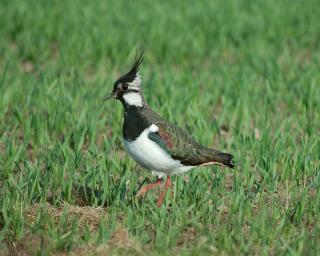How Well Is Farmland Biodiversity Being Maintained In Scotland?
Published on 30 March 2010 in Sustainability and Communities , Ecosystems and biodiversity

Introduction
In 2006 the European Environment Agency highlighted that progress towards achieving the EU’s commitment to halt biodiversity loss on farmland in Europe by 2010 was not visible and that this target was unlikely to be reached without additional integrated policy efforts. In recognition of this, in 2006 the European Commission’s Biodiversity Communication highlighted that their strategy for halting biodiversity loss on farmland by 2010 and beyond would focus on:
- putting greater emphasis on action for the European Union’s most important habitats and species through proposing, designating, protecting and managing effectively the Natura 2000 network of protected areas.
- putting greater emphasis on complementing Natura 2000 and the conservation of threatened species through also encouraging a wider countryside favourable to biodiversity.
Although the Biodiversity Communication placed an emphasis on taking action to address farmland biodiversity concerns (through, for example, optimising the use of agri-environment schemes and preventing intensification or abandonment of High Nature Value farming systems), the main thrust was on encouraging Member States to use existing policy and support mechanisms to help achieve this.
So how has Scottish farmland biodiversity fared over the twenty five years since the introduction of agri-environment schemes within the Common Agricultural Policy (CAP), fifteen years since the introduction of the Biodiversity Action Planning process (with its focus on individual Habitat and Species Action Plans) and nine years since the European Union and its constituent Member States formally declared the aim to halt biodiversity loss in Europe by 2010?
Key Points
Data on the state of farmland biodiversity in Scotland suggest that:
- a focus on designated sites and targeted actions for particular species has improved the condition of many habitats within designated areas and resulted in population increases of a number of species of high nature conservation concern
- these gains have been offset by a continuing decline in the quality of much of Scotland’s wider countryside, with resulting adverse impacts on habitats and species associated with Scottish farming
- halting biodiversity loss on farmland by 2010 will therefore not be achieved fully
Landscape simplification is the key driver of farmland biodiversity declines but it is clear that this cannot be addressed effectively at the scale required solely by using agri-environment schemes within the Scottish Rural Development Programme (SRDP)
Without further major changes to the way that Common CAP support is targeted then Scottish farmland biodiversity is likely to continue to decline.
Any future change in the structure of CAP funding to achieve farmland biodiversity and other environmental goals will require a robust evidence base to inform that policy change.
Research Undertaken
This desk-study of farmland biodiversity status in Scotland was undertaken to form one of the eight sections within the Rural Scotland in Focus report published by SAC in February 2010. That report presents the latest evidence about the way that rural Scotland is changing and provides a commentary on specific issues, challenges and opportunities across the economic, environmental and social landscape of Scotland’s rural areas. SAC’s ambition is that the Rural Scotland in Focus report will provide a stimulus to ongoing debates on the future of rural Scotland, and inform the dialogue on policy and practice options.
An impression of farmland biodiversity trends in Scotland was gained by considering what is known about the condition of sites designated specifically for their nature conservation importance and how particular populations of priority farmland species have changed over the years. The potential ecological health of the wider countryside (i.e. farmland falling outwith designated areas) was also gauged from the results of periodic countryside surveys and a consideration of population trends across broader farmland species groups.
Policy Implications
Landscape simplification could potentially be addressed immediately, and the available limited Pillar 2 funds used more effectively, if all farmers were required to do more than simply maintain their farmland in Good Agricultural & Environmental Condition (GAEC) in order to qualify for Pillar 1 support. In this way, the onus would be put on all farmers to achieve a minimum level of appropriate habitat diversity and/or management at the farm and wider landscape scale in order to qualify for their single farm payment.
Looking to CAP reform post-2013, the way agri-environment schemes are funded could also be changed to increase the cost-effectiveness of such biodiversity actions on the ground. Currently, these schemes tend to be action-based, i.e. they offer payments for adherence to management prescriptions that are assumed to deliver environmental benefits, rather than making payments conditional on realisation of the benefits themselves. There is increasing interest in the potential for introducing payment-by-results schemes as an alternative, more cost-effective, approach. A recent study has suggested a set of generic principles for the implementation of payment-by-result schemes and considered their potential applications at habitat or wider landscape scale.
In Scotland, as elsewhere in Europe, concern about farmland biodiversity declines has raised questions not only about how biodiversity actions on farmland can be better targeted but also about how this can be best achieved and funded. However, if there is an aspiration to increase cross compliance conditions within Pillar 1 of the CAP, to provide additional funds for agri-environment schemes by transferring funds from Pillar 1 to Pillar 2 or to introduce payment-by-results agri-environment schemes, it will be essential to know how well cross compliance is currently delivering environmental benefits, whether Pillar 1 is achieving its objectives, what the impact of Pillar 1 withdrawal would be, what benefits enhanced Pillar 2 funding might deliver and how cost-effective payment-by-results agri-environment schemes would be.
Author
Dr Davy McCracken, SAC davy.mccracken@sac.ac.uk
Topics
Sustainability and Communities , Ecosystems and biodiversity







